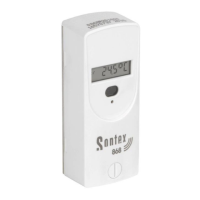18
Instruction for Use | HCA 56x and 8x8
Position 7: Unit Scale and Product Scale:
2 options: unit scale / product scale.
Set the type of scale used when calculating the display values.
By default, the KC and KQ evaluation factors will be set to 1 for the product scale.
Position 8: Set Cumulative Values to Zero:
2 options: set day / never.
Determine whether the units' consumption totaliser will be reset to zero on the set day or
never.
Position 9: Single Sensor or Dual Sensor Mode:
Set the measuring method used by the allocator.
2 options: single sensor / two sensors.
Single sensor: determines the amount of heat emitted by a radiator by measuring and
assessing the radiator's temperature with respect to that of the room temperature measured
at the start and fixed at 20°C.
Two sensors: determines the amount of heat emitted by a radiator based on the measured
temperature of the radiator via the radiator temperature sensor and the ambient air sensor.
Position 10: Elimination of Summer Counting:
2 options: yes / no.
If the 'yes' option is chosen, consumption will not be measured during the summer period.
Position 11: Radiator Temperature TR , Start Counting Summer Period:
Set the threshold temperature for the start (counting) of the allocator. When this start
temperature is reached, the allocator will begin to count the consumption units.
Position 12: Radiator Temperature TR , Start Counting Winter Period:
Set the threshold temperature for the start (counting) of the allocator. When this start
temperature is reached, the allocator will begin to count the consumption units.
Position 13: Max. room temperature TA , Activation of Heat Accumulation Mode, Summer
Period:
Set a reference temperature in order to avoid an incorrect measurement due to heat ac
cumulation (e.g. if the radiator is hidden by panels, thermal accumulation). The allocator
will automatically switch into single-sensor mode when the ambient temperature
measurement surpasses the defined reference temperature. Following this, the calculation
will use an ambient temperature set to 20°C rather than the temperature actually measured.
Position 14: Max. room temperature TA , Activation of Heat Accumulation Mode, Winter
Period:
Set a reference temperature in order to avoid an incorrect measurement due to heat ac
cumulation (e.g. if the radiator is hidden by panels, thermal accumulation). The allocator will
automatically switch into single-sensor mode when the ambient temperature
measurement surpasses the defined reference temperature. Following this, the calculation
will use an ambient temperature set to 20°C rather than the temperature actually measured.
Position 15: Minimum Temperature Difference, Summer Period:
Set a reference value calculated using the temperature difference between the radiator and
theambientair.AccordingtothestandardEN834:TR-TA≤5K.
Position 16: Minimum Temperature Difference, Summer Period:
Set a reference value calculated using the temperature difference between the radiator and
theambientair.AccordingtothestandardEN834:TR-TA≤5K.
Position 17: Standard Ambient Temperature TA, Summer Period:
Ambient temperature value used to calculate the unit's consumption. Set by the standard
EN 834: TA = 20°C.
Position 18: Standard Ambient Temperature TA, Winter Period:
Ambient temperature value used to calculate the unit's consumption. Set by the standard
EN 834: TA = 20°C.
Position 19: Measuring Cycle, Summer Period:
Set a time interval to be used as an operations measuring cycle. The allocator will therefore
usually be in sleep mode.
Position 20: Measuring Cycle, Winter Period:
Set a time interval to be used as an operations measuring cycle. The allocator will therefore
usually be in sleep mode.
Position 21: Commissioning of the Allocator:

